LIONEL LONG, OAM
Singer, guitarist, songwriter,
actor, artist;
1960s-1990s (d. 1998)
The late Lionel Long was
Australia's best-known and most successful folk performer of the 1960s, but his
music was only one facet of a lengthy and varied creative
career
which
also encompassed graphic art, film-making and numerous credits
in
film and TV, both as a presenter and as an actor -- he briefly took over as host of
Sing Sing Sing
during one of JOK's illnesses and then hosted his own national TV variety show in
1963-64; as an actor Lionel is remembered for his starring role as
Detective Bert Costello in Crawford Productions' Homicide
(1968-69).
Considering his diverse talents and his many and varied
achievements and how prominent he was in his heyday, it's lamentable
that there is so little information available on the
Internet about
Lionel's life and work. In part, this simply due to passing
time and fading memory, but there are other factors at work here
-- as music historian Zbig
Nowara has pointed out in his article on Gary
Shearston, historians,
discographers
and
collectors of popular music have tended to ignore
performers like Lionel Long, simply because their work
falls outside the arbitrary boundaries of the "pop-rock" genre.
Another factor is something that we have long
complained about -- the unavailability of so many Australian records of
this period. Lionel Long was one of EMI's most prominent and
successful solo artists for ten years, and
he released more than a dozen LPs during the 1960s, earning several gold
records. Yet only one compilation is currently available and none of his
original EMI recordings have been officially re-released on
CD.
The absence of these recordings is not merely an
inconvenience to "old folkies" -- Long's albums are of interest to any
serious student of Australian popular music, not least because they
feature
some very notable performers, including Dave Guard (the expatriate
American folk musician and founder member of The Kingston Trio),
legendary Australian guitarist and educator Don Andrews,
and renowned jazz musicians like Don Burrows, John
Sangster and Wally Wickham.
Lionel Joaquin Paul Long was the son of a talented
violinist. He grew up in the Hunter Valley and
worked
briefly as a jackeroo before the family moved to Sydney, where Lionel
attended Hawkesbury Agricultural College
and then studied commercial art in Sydney. One of his oldest friends
was another young bush song enthusiast, Gary
Shearston,
and the two spent many Saturday afternoons
learning guitar chords
and trading verses of songs at the Long family home at Rose
Bay. Shearston of course went on to great acclaim as a folk performer
and released a string of successful albums and singles on the CBS label.
Lionel was
'discovered' while a student at Hawkesbury
Agricultural College and was signed to
EMI's
Columbia
label by staff producer Ron
Wills, the man who had produced Slim Dusty's "A Pub With No
Beer" and signed the
young Frank Ifield a few years earlier. According to music
historian Eric Watson, Lionel's
first musical love was country-and-western -- then often called
"hillbilly" or even "hick" music -- and it was only at the
insistence of Columbia that he started to record traditional folk
material.
Folk music became a major force in popular music in the late 1950s
ad early 1960s. The so-called "folk movement" was spearheaded by
the
success of leading American "folk reveival" acts such as
The Kingston Trio, Pete Seeger, Bob Dylan, Joan Baez, Peter Paul &
Mary, and to a lesser extent by Australia's homegrown folk-pop
stars The Seekers. Spurred on by the
examples of their British and American counterparts, local performers
and researchers began to uncover, document and perform Australian folk
songs of the late 18th and 19th centuries, like the perennial "Waltzing
Matilda", "Botany Bay", "Bound For South Australia" and "Moreton Bay",
songs which had grown out of Australia's Anglo-Irish musical heritage
and spoke vividly of our colonial and convict past. "Waltzing Matilda"
in particular became a perennial favourite and the stature that this
song enjoys today is largely the result of it being regularly played
and recorded by Australian folk artists like Lionel Long.
In
cities around the country, the loose network of folk clubs and "coffee
bars" developed into a small but thriving circuit in the period before
the onslaught of The Beatles. Such venues were a training ground
for many local musicians like Doug Ashdown, Patsy Biscoe, Marian Henderson, the late Tina Lawton, Eric
Bogle, John Dengate, Phyl Lobl. Another significant aspect of the
American folk revival was that the repertoire soon expanded to include
African-American music, as folkies began to explore the rich heritage
of American blues and gospel music. Folk music was a powerful vector
for the dissemination of blues to the mainstream popular audience
and it exerted a powerful influence on the emerging pop-rock scene -- a
trend that is perfectly illustrated by the amazing success of "House Of
The Rising Sun", a venerable folk-blues tune that was popularised as a
folk-blues number by Bob Dylan and others and then in turn became a
massive international pop hit when covered by UK 'beat' band The
Animals.
Lionel's first singles were released in 1958, and by the early
1960s Lionel had became
Australia’s most
popular exponent of traditional bush songs, releasing a
string of successful albums for Columbia, averaging an album a year
between 1961 and 1970 . Lionel's debut
LP
Waltzing Matilda
(1961) and the follow-up The
Wild Colonial Boy
(1962) made him a household name, and his profile was boosted by
frequent performances on
radio and TV, including Nine's Bandstand.
His "competent and
unaffected performing style" was showcased in a
successful series of original albums. With the exception
of Waltzing Matilda
(recently reissued in an expanded form) none of Lionel's albums has
been re-released to date.
Lionel Long's Columbia
albums are significant in many respects. His first LPs must
be among the earliest Australian popular albums released in
stereo. As noted above, most of his LPs featured
accompaniment by a distinguished group of session musicians -- most
notably expatriate
American folkie Dave Guard, a founder member of The Kingston
Trio,
who played five-string banjo, 12-string guitar and harmony
vocals, and renowned
Australian guitarist and teacher Don Andrews (author of
the famous series of guitar tuition books).
Other collaborators included jazz legends Don Burrows
and John Sangster, accordionist and entertainer Enzo Toppano
and
vocalist Mary Jane Boyd.
Lionel's 1963 release The
Bold Bushrangers: Songs of Wild Colonial Days was
a
landmark in Australian recording. Much has been made of the fact that
rock acts like Skyhooks used Australian names and idioms in
popular song, but the fact is that they were by no means the first
'popular' act to do so. Whatever the Australian musical identity
might be, there's no doubt that its development is
firmly rooted in the folk music scene of the '50s and '60s, and the
renewed interest in Australian bush songs and ballads that was
prompted by the so-called folk revival of the late 1950s and early
1960s. In this repsect alone, The
Bold Bushrangers is a milestone.
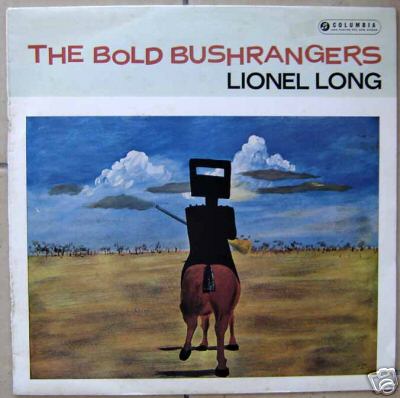 The
'Australian-ness' of the project is clearly signalled by the cover,
which features full colour
reproduction of a detail from one of Sidney Nolan's
iconic 'Ned Kelly' paintings. The original release
was almost
certainly the first ever double-album by an Australian 'popular'
artist, appearing years before either Doug
Ashdown's Age of Mouse
(1969) or Spectrum's Milesago
(1971). It's
also arguably the first
Australian concept album, presenting an extended suite of
songs
about Australia's bushranger folklore, and many featured
lyrics by renowned Australian author, broadcaster and
naturalist Kenneth
Cook (Wake In
Fright).
The
'Australian-ness' of the project is clearly signalled by the cover,
which features full colour
reproduction of a detail from one of Sidney Nolan's
iconic 'Ned Kelly' paintings. The original release
was almost
certainly the first ever double-album by an Australian 'popular'
artist, appearing years before either Doug
Ashdown's Age of Mouse
(1969) or Spectrum's Milesago
(1971). It's
also arguably the first
Australian concept album, presenting an extended suite of
songs
about Australia's bushranger folklore, and many featured
lyrics by renowned Australian author, broadcaster and
naturalist Kenneth
Cook (Wake In
Fright).
"The
Bold Bushrangers
was an ambitious concept double album of songs relating to the first
100 years of European habitation of Australia. Bushrangers ... were
often present on the roads between settlements in the
new colony. These outlaws operated alone or in small groups
and sometimes used names such as "Captain Moonlite", "Thunderbolt",
"The Kelly Gang" and "Cash & Co". The author of many
of the songs on the album was Kenneth
Cook, who set his lyrics against
traditional English, Irish and American tunes of the era after failing
to find sufficient songs of local origin to illustrate a series of
radio talks on bushranging for the ABC."
"Dave Guard, in his first Australian-produced
record appearance, is one of two support musicians on the albums and is
heard prominently on four of the 24 tracks, where the sound of the
long-necked banjo is reminiscent of his Kingston Trio
days. The other
support musician, Don Andrews, is the well-known Australian
jazz and classical guitarist. The lyricist's wife, Patricia
Cook, is the sole
vocalist on four of the tracks in the series. From an
original 12 songs, The
Bold Bushrangers was expanded to include a total of
24. Interestingly, the melodies for two of Dave’s
featured tracks, "Macquarie Harbour Lament" and "Ned Kelly" (on Volume
2), are similar to the more familiar "Haul Away" and "Tomorrow"".
- Ken Bradshaw2
Several Australian folk performers including Lionel Long and Gary
Shearston achieved considerable local popularity, but it sometimes came at a price.
Long's popular success drew strong criticism
from the folk purists, who generally derided any commercial
success as
"selling out". In his overview of the Sydney coffee-lounge
scene of the
1960s, folk
music historian Malcolm J. Turnbull offered
this
view of Lionel's recordings:
"While somewhat slick and marred by
orchestration or
arrangement (the relentlessly buoyant presence of The Delltones, for
instance), in hindsight Lionel Long’s recordings now seem
harmless enough, and imbued with rather more honesty and love of the
material than the critics have conceded. His output was also more
varied than has generally been recognised."
Lionel and Graham Jenkin compiled the book Australian
Bush Songs (Rigby, 1964) but, according to Malcolm
Turnbull, the book's
failure to adequately acknowledge the original sources of
material made Long persona non gratis
with folksong collectors and scholars. Long countered accusations of
commerciality as "all self-conscious stuff and
garbage", claiming that he had more first-hand knowledge than
most of his critics, having "drunk heartily of outback life,
shearing sheds and the open land". In his view, there was:
"no
excuse ... for the lack of interpretation or imaginative
presentation or phrasing to any song, particularly a folk
song. Immediately one of these 'purists'
earns something from folksongs, he himself becomes 'commercial', so
frankly I can see no argument.
Call me a folksinger or a balladeer if you like, but privately I regard
myself as an individualist."1
Criticisms about his style and commercial success clearly had
an effect. On his 1965 album Long
Ago, which
featured new versions of traditional British folks songs, there was a
direct
reference to these critiques in the back-cover notes, where Long
was quoted as saying:
"I sing my songs in the way that I feel
them for everyone's
enjoyment, which may not necessarily conform with the maner that some
of the purists would prefer."
Long made numerous TV appearances in the early 1960s
on Bandstand
and other music-variety programs; his first big break as
a presenter came in late
1962. The previous year, rock legend Johnny O'Keefe had moved from
the ABC to Channel 7 to host The Johnny O'Keefe Show
but in August 1962, after repeated clashes with his
unstable star, series director Ron Way walked off the show and took
most
of the staff with him. Weeks later O'Keefe suffered a major
mental breakdown and was hospitalised for two months, so Long
was
quickly recruited to taek over as host, which was relaunched as Sing Sing
Sing. By early 1963 O'Keefe had recovered enough
to patch up his
differences with Way, and he returned to Sing Sing Sing in
February
1963. Soon after, Long was given his own musical variety series, Music
Time, which ran until 1964.
Lionel
was married to Carole Newgrosh around this time (1963?); a photo of the couple on their wedding day is preserved in
the collection of the State Library of Victoria. His
1964 LP Songs of the Sea
was his first album not devoted exclusively to Australian songs, and
only one related to the colonial past. It was a
project close to his heart -- like his friend Gary Shearston, Lionel
was a keen sailor and owned several boats. The
liner notes recount Lionel Long’s memories of deep sea
fishing
with an old man in the snapper grounds off Port Macquarie, New South
Wales, his own attempt as a ten year old to sail in a rubber dinghy 80
miles from Sydney to Newcastle, the boats which he owned up to a 27
foot Thunderbird class yacht and those members of his family who had
some connection with the sea, including one who was the first
Australian naval man to set foot in Alaska. Many of Lionel's
contemporaries have fond memories of days spent sailing with him.
On 1 August 1964 Lionel was one of the
stars of the
TV
variety spectacular This
Is It,
which celebrated the first night of
broadcasting of Melbourne's third commericial TV station Channel 0. The
special also featured Diana Trask, Ray Taylor and
Vikki Hammond and was hosted by the station's original newsreader,
Barry McQueen. During the year he also narrated a film about the 1964
Ampol Car Trial, directed by Keith Gow.
His next LP Songs Of A
Sunburnt Country
returned to Australian themes; it included two spoken-word tracks,
Dorothea Mackellar's "My Country" and Banjo Patterson's famed "The Man
From Snowy River"; other notable tracks were "The note on the woolshed
wall" (originally recorded as the B-side of his second single back in
1958) and teh 'Queensland version' of the perennial favourite "Waltzing
Matilda".
By the
mid-1960s Lionel was broadening his musical repertoire to
include popular Australian and international
songs of the era, although these releases were apparently not
as successful as his earlier 'Australiana' recordings. His
commercial fortuntes were undoubtedly also being affected by
the
impact of "beat" music and the
guitar-group phenomenon, which had decimated the popularity of
folk and jazz.
Lionel was particularly drawn to the work of American
guitarist and songwriter Mason
Williams,
who is best known for the
1968 novelty hit "Cinderella Rockefella" (locally covered by Anne
&
Johnny Hawker) and for his enduring 1970 instrumental hit "Classical
Gas". Lionel again broke new ground with his 1966 LP
Amberwren and Other Folk
Songs, devoting the entire first
side of the album to the Williams-penned title track, and he recorded
three more of Williams' songs, "Them Poems", "The Dancing
Distance" and "Life Song", on his 1967 LP Lionel Long Today. Another notable inclusion was the Barry Gibb song "Follow The Wind", one of
many Bee Gees songs that the trio never recorded
themselves.
 Concurrent
with his musical career, Lionel also branched out into acting. Early dramatic
roles were in the Aussie TV adventure series Whiplash (1961) and
Riptide
(1965). He travelled to the UK ca. 1964, where
he made his first
big-screen appearance, winning a cameo
role in the comedy The
Amorous Adventures of Moll
Flanders, starring Kim Novak in the title role
and directed by Terence Young (of James Bond fame).
Concurrent
with his musical career, Lionel also branched out into acting. Early dramatic
roles were in the Aussie TV adventure series Whiplash (1961) and
Riptide
(1965). He travelled to the UK ca. 1964, where
he made his first
big-screen appearance, winning a cameo
role in the comedy The
Amorous Adventures of Moll
Flanders, starring Kim Novak in the title role
and directed by Terence Young (of James Bond fame).
While in Europe he also
acquired a custom-built lute, made with a standard six-string guitar
tuning
instead of the tradional four double-strings. He used this on
his 1965 LP Long
Ago: Folk Songs of the British Isles (later reissued as Troubador on Paul
Hamlyn's Music For Pleasure label), and photos showing Lionel playing
the lute were used on three album covers -- Songs of a Sunburnt Country,
Long Ago
and Amberwren.
Left: a publicity photo of
Lionel Long as
Det. Bert Costello in Homicide
Long's
best-known TV role came in the late
Sixties, when he was chosen for the role of Detective Bert
Costello in Homicide.
His character, an Italian-Australian, was only intended to appear for a
few weeks but he quickly became so popular that Long remained with the
series for a year, appearing in sixty
episodes during 1968-69. He was eventually was
written out when his character was killed in a mineshaft
cave-in, and replaced by Norman Yemm.
Lionel made many appearances in Crawford and other dramas
-- his later Australian
TV credits included The
Rovers (1970), Nine's shortlived police drama The
Link Men (1970), Division
4 (1972), Spyforce
(1972), Matlock Police
(1971 and 1974), Solo
One (1976), Chopper
Squad (1978) and A
Country Practice (1986); he also had roles in the films Inn of the Damned
(1975) and Barney
(1976).
Long's last Columbia LP Close
Up
(which features a rather bizarre cover shot of a group of young steers)
was issed in 1970, and this evidently marked the end of his EMI
contract. He then signed with RCA and returned
to his earlier more successful folk-song style; he recorded three LPs
in the early 1970s -- The Man From Snowy River, Australia! Australia!
and Brandied Plums, and RCA issued several singles.
Lionel returned to EMI
for his last album, High
Wild & Handsome
(1980). Recorded with assistance from renowned guitarists Kirk L'Orange
and Tommy
Emmanuel, it featured a broad range of material
including "Sometimes when we touch", The Beatles "Let It Be"
and "The Rainbow Connection". As he recalled to Peter Thomspon
in a
recent episode of the ABC's Talking
Heads, Tommy Emmanuel launched his solo career in Sydney
working as Long's
accompanist and Musical Director:
"Yeah. Well, I moved away from Parkes and
I got the job [a messenger boy for Angus & Coote] like that,
and
that afternoon I went to meet with Lionel Long ... and I auditioned for
him and I got that job as well. So, I'd work with Lionel on the
weekends as his guitar player and musical director"
Lionel Long's work as a graphic artist
is not well documented but he undoubtedly produced many works, and we
hope to identify more of these in the future. One project in which he
is known to have been invovled was for the publishing company Rigby.
Over a number of years (1966 to 1981) Rigby issued a series of small
souvenir books devoted to Australasian towns cities,regions and areas
of architectural interest, including the three major cities in New
Zealand, and also Fiji. About 175 titles were issued; the general
format was 64 pages with about 28 full-page drawings, each with a
facing page of descriptive text. Artists and authors ranged from
obscure to famous;. Lionel contributed drawings to two volumes in this
series, Liverpool
(NSW) and Newcastle,
both published in 1980, with text by Brian Davies.
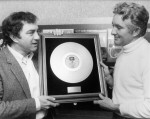 In July 1981
Lionel donated one of his gold albums to the National Library
of Australia. The photo (left) by Martin Jones, sourced from the ACT Heritage Library website,
shows Lionel presenting the Gold Disc to NLA archivist Peter Burgis on
15 July 1981.
In July 1981
Lionel donated one of his gold albums to the National Library
of Australia. The photo (left) by Martin Jones, sourced from the ACT Heritage Library website,
shows Lionel presenting the Gold Disc to NLA archivist Peter Burgis on
15 July 1981.
Lionel continued performing into the late 1980s. According to
Ken Bradshaw one of his last major engagements
was a show at the
Sydney
Opera House in 1987. In 1992, he went at Nashville for several months
to work on publishing deals. In the Australia
Day
honours in January 1993
Lionel and veteran producer Ron Wills were both awarded the OAM (Order
of
Australia Medal) in recognition of their contributions to Australian
music.
Lionel Long died in the Sacred Heart
Hospital at Darlinghurst, Sydney, on 1 January 1998. He was cremated in
a small service at the Eastern Memorial Park at Matraville, Sydney.
Discography
Singles
1958
(EMI
Columbia DO-3992)
"Hi-Di-Derry-Down-Dey" / "I love you best of all"
1958 (EMI
Columbia DO-3993)
"Mighty Pyramid" / "The note on the woolshed wall"
1959 (EMI
Columbia DO-4099)
"Searching" / "The Bunyip"
1959 (EMI
Columbia DO-4100)
"The Ballad of Cobb & Co." / "The girl with the
auburn hair"
1961 (EMI
Columbia DO-4234)
"Botany Bay" / "Ring-A-Ling"
1965 (EMI
Columbia DO-4618)
"True, True Loving" / "Love Is An Eagle"
1967 (EMI
Columbia DO-5024)
"Missin' You" / "Got A Feelin'"
1968 (EMI
Columbia DO-5062)
"To The End Of The World" / "Somewhere In A Rainbow"
1974 (RCA
Victor 102536)
"The Old Colonial Chair" / The Gunner and the Baron"
1975? (RCA
102626)
"Cash & Co." / "10,000 Miles"
1980 (Arrival
AR-107)
"Blanca Rosa" / "Six-pack of memories"
EPs
1960? (Viking
VSP-15)
Australia
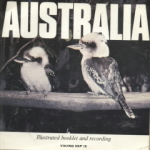
Side
1
"Waltzing Matilda" (Lionel Long)/
"Wongga"
(Aboriginal corroboree) / "Wallaby Stew" (Lionel Long) / Kookaburra
Chorus (bird call)
Side 2
"Click Go The Shears" (Lionel Long) / Walaka
(Aboriginal dance) / "Botany Bay" (Lionel Long)
Record and booklet featuring Australian folk
songs, Aboriginal songs and dances and bush sounds (possibly a tourist
promotion)
1961?
Lionel Long
(EMI Columbia SEGO-70083) with the Noel Gilmour Sextet

Side 1
1. "Waltzing Matilda" 2. "On the banks of the Condomine"
Side 2
1.
"Wallaby stew" - 2. "The Wild Colonial Boy"
Albums
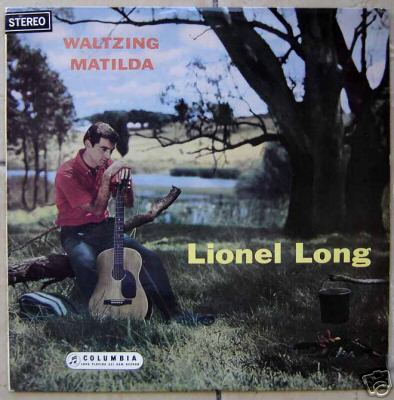
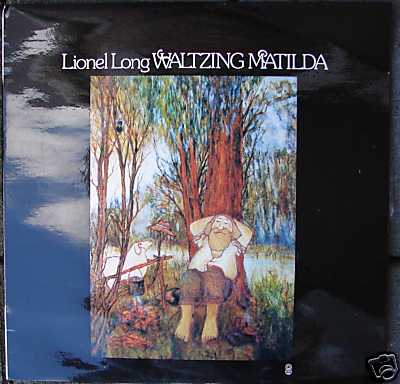 |
1961 (EMI
Columbia 33OSX-7641 mono, SCXO-7506 stereo)
Waltzing Matilda
Also released on World Record Club (SLZ-8609)
Reissued on CD by Gum Tree Music, 2005
1. "Waltzing Matilda"
2. "Wallaby Stew"
3. "Reedy Lagoon"
4. "The Old Bullock Dray"
5. "Moreton Bay"
6. "The Drover's Dream"
7. "Click go the Shears"
8. "The Wild Rover"
9. "Botany Bay"
10. "Rush Away"
11. "Ring-A-Ling"
12. "The Ballard of Cobb and Co."
Additional
tracks on CD reissue:
"The Wild Colonial Boy"
"The Stockman's Last Bed"
"Ned Kelly"
"Namatjira"
"The Black Velvet Band"
"Click Goes The Shears"
"Wild Rover No More"
Lionel Long (guitar, vocals)
with The Noel Gilmour Sextet and The Delltones
Right, top: the
original Columbia release of Waltzing
Matilda;
Below:
the World Record Club release with cover illustration possibly
by Lionel Long |
1962 (EMI
Columbia 33OSX-7674 mono, SCXO-7674
stereo)
The Wild
Colonial Boy
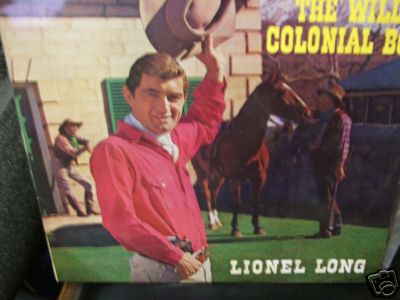
Side 1
1. "The Overlander"
2. "The Crocodile"
3. "The Stockman's last bed"
4. "The Dalby Ram"
5. "Jabbin Jabbin"
6. "Ten Thousand Miles"
7. "The Wild Colonial Boy"
Side 2
1. "On the Banks of the Condamine"
2. "The Old Bark Hut"
3. "The Brisbane Ladies"
4. "Dust in the Sun"
5. "The Black Velvet Band"
5. "A Nautical Yarn"
6. "Fool's Gold"
Produced by Ron Wills
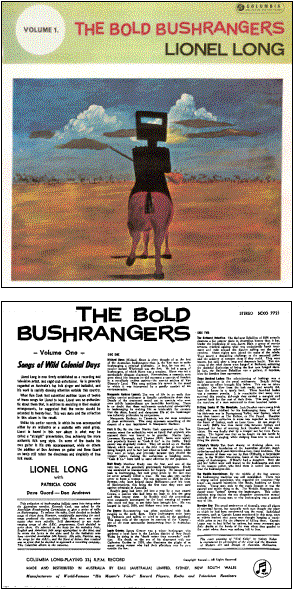 |
1963
The Bold Bushrangers
(Columbia
SCXO 7693/4 stereo;
33OSX 7693/4 mono) 2LP
Later issued
in two volumes
with identical front cover art by Sidney Nolan
(Columbia SCXO
7721, stereo;
33OSX 7721, mono)
Re-released in separate LP format
ca
1968 (Columbia SOEX
9512 and 9513, stereo)
Side
1
"Michael Howe"
"Macquarie Harbour Lament*
"Cash and Co."
"Matt Brady"
"The Cyprus"
"Jamie Greene"
Side 2
"The Bathurst Rebellion"*
"300 Lashes"
"O'Meally's Shanty"
"Drifting Smoke of the Mountain"
"Weddin Mountaineer"
"Moreton Bay"
Side 3
"Captain Moonlite"
"The Wild Colonial Boy"
"Go Tell Your Father"*
"Weddin Mountains Lament"
"Sir Frederick Pottinger"
"Ben Hall"
Side 4
"Jackie and Darkie"
"Jimmy Grant's Lament"
"Thunderbolt"
"Ballad of the Peacock"
"Glenrowan Farewell"
"Ned Kelly"*
Lionel Long (guitar, vocals)
Patricia Cook (vocals)
Dave Guard (five-string banjo)*
Don Andrews (guitar)
Produced
by Ron Wills
|
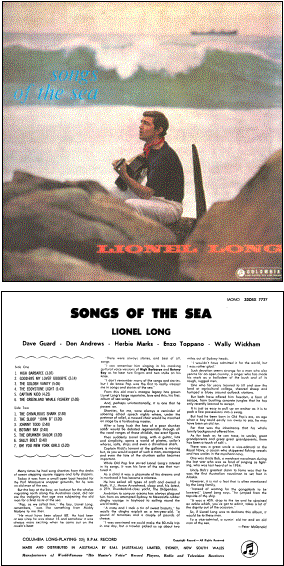 |
1964
Songs of the
Sea (EMI Columbia 33OSX-7727)
Side
1
1. "High Barbaree"
2. "Good-bye my lover goodbye"
3. "The golden vanity"
4. "The Eddystone light"
5. "Captain Kidd"
6. "The Greenland whale fishery"
Side 2
7. "The Chivalrous shark"
8. "The Sloop 'John B' "
9. "Johnny Todd"
10. "Botany Bay"
11. "The Drunken sailor"
12. "Sally Bolt"
13. "Oh! You New York girls"
Lionel Long (guitar, vocal)
with
Don Andrews (guitar)
Dave Guard (guitar, banjo)
Herbie Marks, Enzo Toppano (accordion)
Wally Wickham (bass)
|
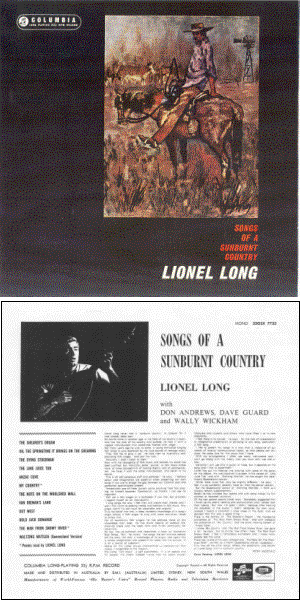 |
1964 (EMI
Columbia 33OSX 7733)
Songs of a
Sunburnt Country
1. "The Shearer's dream"
2. "Oh, the springtime it brings on the shearing"
3. "The Dying stockman"
4. "The Lime juice tub"
5. "Anzac Cove"
6. "My country"*
7. "The note on the woolshed wall"
8. "Van Dieman's Land"
9. "Out west"
10. "Bold Jack Donahue"
11. "The Man from Snowy River"*
12. "Waltzing Matilda" (Queensland Version)
(*spoken word performance)
Lionel Long (guitar, vocal)
with
Don Andrews (guitar)
Dave Guard (guitar, banjo)
Wally Wickham (bass)
|
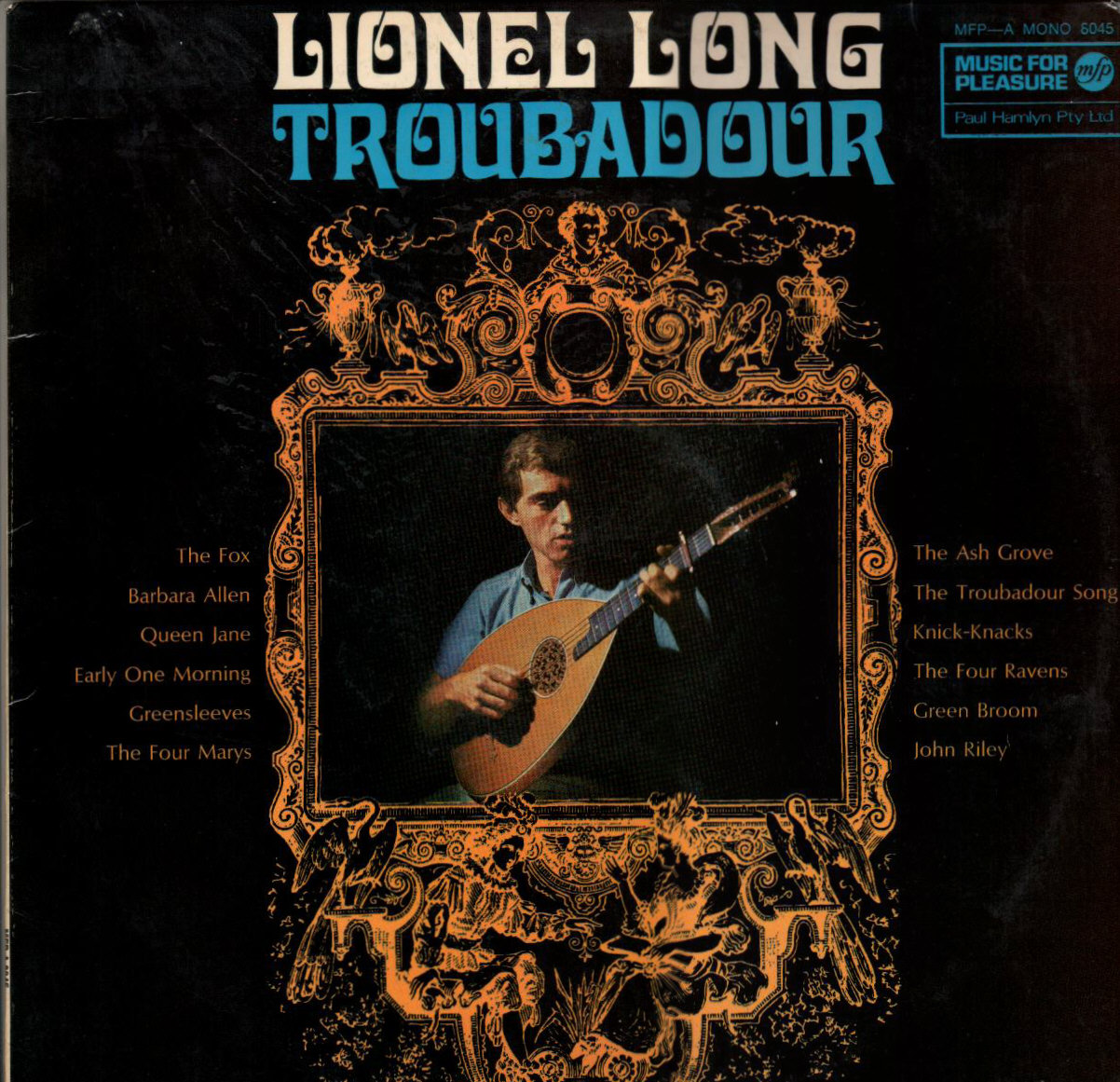 |
1965
(EMI
Columbia 33OSX-7714)
Long
Ago: Folk Songs of the British Isles
Reissued as Troubadour
(Music For Pleasure MFP-A-8045)
Side 1
1. "The Fox"
2. "Barbara Allen"
3. "Queen Jane"
4. "Early One Morning"
5. "Greensleeves"
6. "The Four Marys"
Side
2
1. "The Ash Grove"
2. "The Troubadour Song"
3. "Knick Knacks"
4. "The Four Ravens"
5. "Green Broom"
6. "John Riley"
Lionel Long
(guitar, lute, vocals)
with Don Andrews (guitar)
Mal Cunnigham (recorder)
|
|
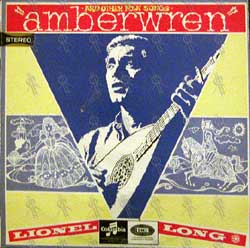
|
1966?
"Amberwren" and
Other Folk Songs (EMI Columbia 33OSX-7755)
Side One
1. "Amberwren" (Mason Williams)
Side
Two
1. "I Dreamed of Two Ships"
2. "Two Doves"
3. "Farewell"
4. "Namatjira"
5. "Turn, turn, turn"
6. "Boll Weevil"
Produced by Ron Wills
|
1967?
Lionel Long
Today (EMI Columbia 33OSX-7787)
[no image available]
Side 1
1. "Piney Wood Hills"
2. "The Dancing Distance" (Mason
Williams)
3. "Love Minus Zero (No Limit)" (Bob
Dylan)
4. "Flowers of Peace"
5. "Follow the Wind" (Barry Gibb)
6. "Many a Mile"
7. "Them Poems" (Mason Williams)
8. "Life Song" (Mason Williams)
Side 2
1. "Alberta"
2. "Blind Men Wander"
3. "The Marvellous Clouds"
4. "Less of Me"
5. "Come the Time"
6. "A Repco Brabham Car"
7. "The Green Years"
Lionel Long (vocal, guitar)
with
Don Andrews (guitar)
John Sangster (vibes)
Don Burrows (flute)
1968
Walkabout (EMI
Columbia SCXO-7905)
Side 1
1. "Bindi-i-i"
2. "Curraweena Station"
3. "Lucky Opals"
4. "Thursday Island Girl"
5. "Legend of Pirili"
Side
2
1. "600 Miles"
2. "Westward"
3. "Jet Plane"
4. "Thar She Blows"
5. "A Town Like Alice"
6. "Nick The Greek"
|

|
1970 (EMI Columbia
SCXO-7986)
Close
Up
1. "Ribbon of darkness"
2. "Sing me back home"
3. "Sugar cane country blues"
4. "Mama tried"
5. "Wildwood flower"
6. "Believe me Lord"
7. "Ned Kelly" (Shel Silverstein)
8. "I take a lot of pride in what
I am"
9. "The Great white horse"
10. "Muleskinner's son"
11. "Shade tree Fix-it-man"
12. "I am off to Kambalda"
Lionel
Long (vocal, guitar)
with
Mary Jane Boyd (vocal)
|
1973
The man
from snowy river (RCA MSL-102300)
[no image available]
1. "The Man
From Snowy River"
2. "The Man From Iron Bark"
3. "The Women Of the West"
4. "The Old
Bush School"
5. "The Ballad Of The Drover"
6. "The Lights of Cobb
& Co".
7. "Ned Kelly"
8. "Said Hanrahan"
9. "Across Bass
Strait"
10. "The Loaded Dog"
1974
(RCA
Victor SP-150)
Brandied
Plums
Side
1
1. "Sailin' for Australia"
2. "Invisible Dan"
3. "Old Colonial Chair"
4. "Sugarcane Flo and Paddymelon Joe"
5. "Moreton Bay Gaol"
6. "The Indian-Pacific"
Side
Two
1. "Wollombi River Road"
2. "Drifting Smoke of the Mountain"
3. "The Gunner and the Baron"
4. "Clancy of the Overflow"
5. "Turn Again"
6. "Destiny's Ballard"
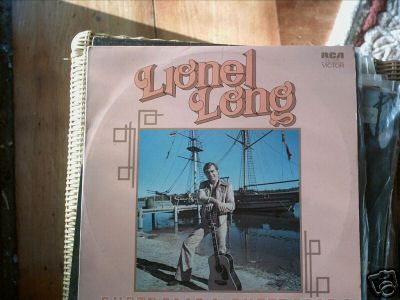 |
1975
(RCA Victor VCL1-0229)
Australia!
Australia!
1. "Cash and Co."
2. "Click go the shears"
3. "10,000 miles"
4. "The wild colonial boy"
5. "The banks of the Condamine"
6. The Brisbane ladies
7. "Waltzing Matilda"
8. "Razorback (moonlight rider)"
9. "On the banks of the reedy lagoon"
10. "Botany Bay"
11. "The wild rover"
12. "Wallaby stew"
Produced by Tweed
Harris
|
1980
High, Wild and
Handsome (EMI)
[no image available]
1. "Blanca Rosa"
2. "Sometimes when we touch"
3. "I can't even mend a broken heart"
4. "Song for J.O'K"
5. "Taking the easy way out"
6. "High, wild and handsome"
7. "Let it be"
8. "Six-pack of memories"
9. "If I could only dance"
10. "The Rainbow connection"
11. "Movie in my mind"
12. "Mr. Nice Guy"
Lionel Long (guitar, vocal)
with
Kirk L'Orange (guitar)
Tommy Emmanuel (guitar)
Recorded at EMI Studios 301, Sydney
References / Links
1. Malcolm J.
Turnbull
The History
of the Australian Folk Revival
http://warrenfahey.com/revival.htm
2. Ken Bradshaw
"Dave's Place"
http://www.lazyka.com/linernotes/DavesPlace/DFDU--pt3.htm
3. Classic Bands
Frank Ifield Interview
http://www.classicbands.com/FrankIfieldInterview.html
4. John Byrell
Bandstand
and all that (Kangaroo Press, 1995), pp. 57, 103
5. National Film
& Sound Archive of Australia
http://www.nfsa.gov.au
Australian
Television Memorabilia
http://www.tvmem.com/OZST/ffilms/N-FFILM/NEDKELL1.htm
ABC-TV
Talking Heads: Tommy
Emmanuel
http://www.abc.net.au/talkingheads/txt/s1587113.htm
Photo links
ACT Heritage
Library
1981 photo of Lionel Long with NLA archivist Peter Burgis, presenting
one of two gold records he donated to the National Library
http://www.basis.act.gov.au/DUSLibrary/ImagesACT.nsf/3506a89b45287c52ca256abc000c49a8/5fa34801f6046d494a256cc800823be6!OpenDocument
State Library of
Victoria
 The
'Australian-ness' of the project is clearly signalled by the cover,
which features full colour
reproduction of a detail from one of Sidney Nolan's
iconic 'Ned Kelly' paintings. The original release
was almost
certainly the first ever double-album by an Australian 'popular'
artist, appearing years before either Doug
Ashdown's Age of Mouse
(1969) or Spectrum's Milesago
(1971). It's
also arguably the first
Australian concept album, presenting an extended suite of
songs
about Australia's bushranger folklore, and many featured
lyrics by renowned Australian author, broadcaster and
naturalist Kenneth
Cook (Wake In
Fright).
The
'Australian-ness' of the project is clearly signalled by the cover,
which features full colour
reproduction of a detail from one of Sidney Nolan's
iconic 'Ned Kelly' paintings. The original release
was almost
certainly the first ever double-album by an Australian 'popular'
artist, appearing years before either Doug
Ashdown's Age of Mouse
(1969) or Spectrum's Milesago
(1971). It's
also arguably the first
Australian concept album, presenting an extended suite of
songs
about Australia's bushranger folklore, and many featured
lyrics by renowned Australian author, broadcaster and
naturalist Kenneth
Cook (Wake In
Fright). Concurrent
with his musical career, Lionel also branched out into acting. Early dramatic
roles were in the Aussie TV adventure series
Concurrent
with his musical career, Lionel also branched out into acting. Early dramatic
roles were in the Aussie TV adventure series  In July 1981
Lionel donated one of his gold albums to the National Library
of Australia. The photo (left) by Martin Jones, sourced from the
In July 1981
Lionel donated one of his gold albums to the National Library
of Australia. The photo (left) by Martin Jones, sourced from the 










